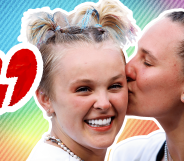Q&A: The Equal Love campaign’s legal case

This week, four gay and four straight couples will file a challenge at the European Court of Human Rights against the UK’s ban on gay marriage and straight civil partnerships.
The campaign is being led by Peter Tatchell and aims to allow all couples access to both institutions.
Here, human rights lawyer and case advisor Professor Robert Wintemute explains the legal basis of the application to the European Court of Human Rights.
Why is the case being taken directly to the European Court of Human Rights, without first exhausting the UK courts?
Professor Wintemute: We have decided to take our case directly to the European Court of Human Rights for two reasons.
First, anyone challenging discriminatory legislation under the Human Rights Act 1998 has to worry that losing could mean being ordered to pay the UK government’s legal costs. This happened in 2006 to a lesbian couple, Susan Wilkinson and Celia Kitzinger, when they tried to have their lawful Canadian marriage recognised as a marriage in the UK.
Our government would only recognise it as a civil partnership. Their case was rejected by a High Court judge, who ordered them to pay the UK government £25,000 in legal costs. They could not afford to appeal the decision. In contrast, individuals who lose in the European Court of Human Rights do not have to pay the UK government’s legal costs. The eight couples bringing this joint legal action are not well off and are not in a position to take the risk of a potentially huge legal bill.
Second, even if we were to win in a UK court, the Human Rights Act 1998 only allows a UK court to make a ‘declaration of incompatibility’, if the court deems legislation to be discriminatory. The Matrimonial Causes Act 1973 states that the parties to a marriage must be male and female. The Civil Partnership Act 2004 stipulates that the parties to a civil partnership must be of the same sex. A ‘declaration of incompatibility’ is not legally binding, so the UK Government is free to ignore it.
Even if the declaration is made by the UK Supreme Court, the UK government is able to say: ‘We’ll wait to hear what the European Court of Human Rights has to say.’ This limit on the powers of UK courts under the Human Rights Act 1998 is a defect in the UK’s legal protection of human rights. Because of this defect, the European Court of Human Rights confirmed in 2008 that a ‘declaration of incompatibility’ is not an effective remedy, and does not have to be exhausted before making an application to the Court against the UK government.”
What are the key points and arguments of the Equal Love legal case?
Our case is that the combination of the Matrimonial Causes Act 1973 and the Civil Partnership Act 2004 creates a system that segregates couples into two separate legal institutions, with different names but identical rights and responsibilities. The segregation of couples is based on their sexual orientations: same-sex couples are excluded from marriage, and different-sex couples are excluded from civil partnership.
Under Article 14 of the European Convention on Human Rights, all differences in treatment affecting other Convention rights – in this case the rights to marry in Article 12 and to respect for family life in Article 8 – must have an ‘objective and reasonable justification’. The European Court of Human Rights has said that differences in treatment based on sexual orientation ‘require particularly serious reasons by way of justification’, like differences in treatment based on race, religion or sex.
The only apparent reason for maintaining the system of segregation is to use the law to mark same-sex couples as socially and legally inferior, and different-sex couples as socially and legally superior. Same-sex couples are excluded from marriage, which is the universal system for legally recognising a loving, committed, sexual relationship between two adults. This legal segregation is similar to having separate beaches and drinking fountains for white and black people, as existed in South Africa under apartheid. It is comparable to having a system of marriage for Christians and civil partnership for non-Christians.
Why previous ECHR rulings against same-sex marriage might not apply in this case
On 24 June 2010, the European Court of Human Rights issued its first judgment in a case in which a same-sex couple was seeking the right to marry. The court found no violation of the European Convention on Human Rights in the case of two men, Horst Schalk and Johan Kopf, who were seeking the right to marry in Austria.
Although the court ruled that Article 12 of the Convention did not yet impose an obligation on European governments to allow same-sex couples to marry, the court changed its interpretation of Article 12, saying that it ‘would no longer consider that the right to marry enshrined in Article 12 must in all circumstances be limited to marriage between two persons of the opposite sex’.
When more Council of Europe countries than the current seven (out of 47) allow same-sex couples to marry, the court will be willing to consider ordering all of them to do so. The number of European countries that allow same-sex marriage increased from three in 2005 to seven in 2010, and could double again while this case is pending. Same-sex marriage bills are currently being considered by the parliaments in Luxembourg and Slovenia, and a bill is expected soon in Finland. With a change of government, Denmark and France may follow suit.
In our case, we are not asking the court to order Italy, Poland, Russia, Turkey, Ukraine and 35 other Council of Europe member states to allow same-sex couples to marry. Some countries in continental Europe, like Austria, do not want to allow same-sex couples to marry, because they are not ready to allow them to adopt children jointly, or to grant lesbian couples access to donor insemination.
But this is not the situation in the UK. In 2002, same-sex couples in England and Wales were granted the right to adopt children jointly. In 2004, they won the right to register a civil partnership and acquire all of the rights of married different-sex couples, except in relation to assisted reproduction. In 2008, they achieved full equality in relation to assisted reproduction, including donor insemination. We are asking the court to require the UK government to explain why, after taking these politically difficult decisions voluntarily, and having gone so far to ensure equality between marriage and civil partnerships, the UK should be allowed to withhold access to marriage from same-sex couples, and access to civil partnership from different-sex couples. Given that UK marriages and civil partnerships confer identical rights and responsibilities, the UK government will have to justify to the European Court its maintenance of two different institutions that discriminate based on sexual orientation.
We will draw on the EU Court of Justice’s requirement of consistency, set out in its Maruko judgment in 2008. The EU Court ruled that it was up to Germany to decide whether or not to have a registered partnership law for same-sex couples, and how many rights to grant registered same-sex partners. But once Germany decided voluntarily to pass a registered partnership law, and to put registered same-sex partners ‘in a situation comparable to that of spouses’, Germany could not exclude them from survivors’ benefits under employment-related pension plans that fell within the scope of EU anti-discrimination law. EU freedom of movement law also requires consistency with regard to the immigration rights of same-sex partners who are not EU citizens, ‘if the legislation of the host Member State treats registered partnerships as equivalent to marriage’.
Our case is essentially that the European Convention on Human Rights, read in conjunction with developments in European Union law, imposes an obligation of consistency on European governments that voluntarily create an institution like civil partnership, and then grant same-sex civil partners all of the rights of different-sex spouses.
The European Court of Human Rights should, as a matter of consistency and for the avoidance of pettiness, require the UK and other countries in the same position, like Denmark, to take the final step and grant access to the institution of marriage. Anyone who has attended a civil partnership ceremony, and seen how similar it is to a marriage ceremony, knows how extraordinarily petty it is for the UK government to say that a same-sex couple can have all the rights and responsibilities of marriage through an institution with a different name (civil partnership) but cannot have access to the word and institution of marriage.
What are the chances of success?
I am confident that we have a good chance of persuading the European Court of Human Rights that the UK’s system of segregating couples into two ‘separate but equal’ legal institutions violates the Convention. I would predict that same-sex couples will be granted access to marriage in the UK and that this will be because the UK government will eventually accept that they cannot defend the current discriminatory system. The UK government should settle the case, and voluntarily introduce a bill in the UK parliament, so that the European Court of Human Rights does not have to issue a judgment. This bill should simply repeal the twin bans on same-sex marriage and different-sex civil partnership, and give every couple, different-sex or same-sex, a choice of marriage or civil partnership, as in the Netherlands, Quebec and South Africa. This bill would bring ‘Equal Love’ to the UK.
Background information
Segregation of couples in UK law, based on sexual orientation:
Matrimonial Causes Act 1973, s. 11: “A marriage … shall be void [if] … the parties are not respectively male and female …”
Civil Partnership Act 2004, s. 3(1): “Two people are not eligible to register as civil partners … if they are not of the same sex …”
Countries, provinces and states with marriage for same-sex and different-sex couples:
17 – Argentina, Belgium, Canada, Iceland, Netherlands, Norway, Portugal, South Africa, Spain, Sweden, USA (Connecticut, Iowa, Massachusetts, New Hampshire, Vermont, District of Columbia), Mexico (Federal District)
Countries, provinces and states with civil partnership for same-sex and different-sex couples:
11 – Australia (Australian Capital Territory, New South Wales, Tasmania, Victoria), Canada (Québec), Netherlands, New Zealand, South Africa, USA (Illinois, Nevada, District of Columbia)
Countries, provinces and states with both marriages and civil partnerships open to gay and heterosexual couples ie. “Equal Love”:
3 – Canada (Québec), Netherlands, South Africa.

